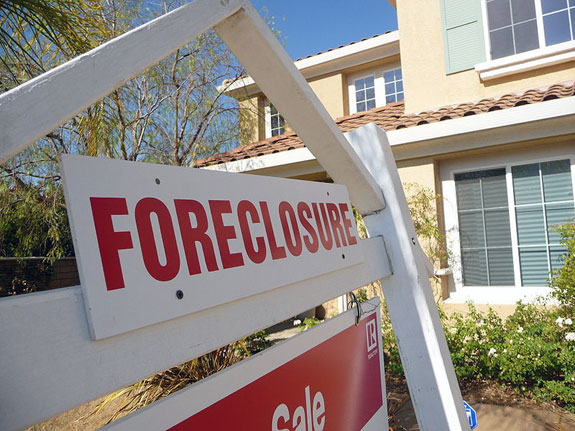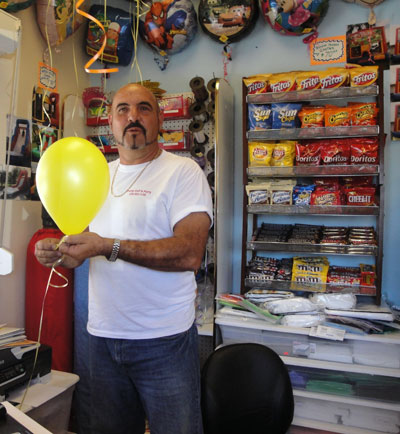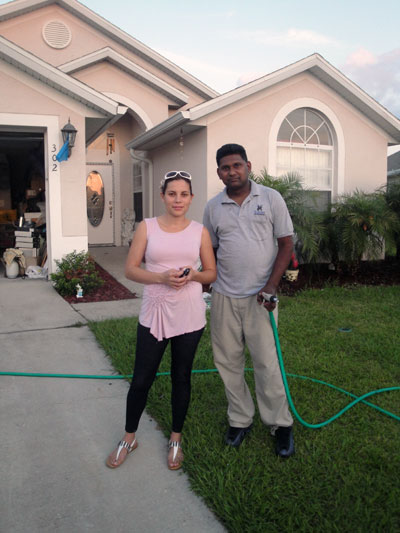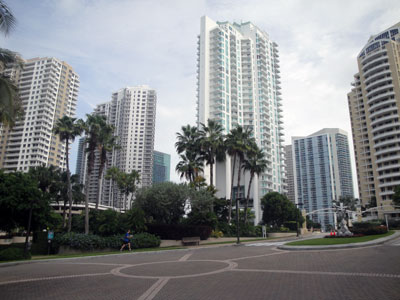
By Ralph De La Cruz
Florida Center for Investigative Reporting
There’s no doubt what the F-word has come to mean in Florida during the past three years.
Foreclosure.
About This StoryThe Florida Center for Investigative Reporting examined foreclosure density in the Sunshine State in partnership with media organizations including The Ledger in Lakeland, the St. Petersburg Times, the Florida Times-Union in Jacksonville, and HolaTV. Interactive Statewide DataInteractive County-by-County Data Review the foreclosure risk score for your ZIP code, in the following counties:
|
There are almost 40,000 properties now in foreclosure in the Sunshine State. Almost 30,000 more are in the short sale process, which means homeowners are underwater on their homes and are trying to sell them for less than they owe the bank. Another 56,000 are in preforeclosures — homeowners are behind on their mortgage payments and are at risk of foreclosure. These are the short sales and foreclosures of tomorrow.
And this is the best it’s been in four years.
Just two years ago, in 2009, the state had 516,711 foreclosure listings. That was almost 6 percent of the state’s entire housing stock.
Things became so bad — Lee County alone had a 25,000-case backlog — that the state hired back former judges to hear the backlog of cases. Funded by federal stimulus money, the courts became known as “rocket dockets.”
Using expedited procedures, the judges ripped through their dockets, sometimes at a 1,000-case-per-day clip. The only pertinent question was: Are you behind on your payments? Some cases were closed in seconds. So fast, homeowners’ lawyers complained, that shortcuts were being taken and their clients’ cases weren’t really being heard.
The American Civil Liberties Union filed a petition asking the courts to stop using the expedited measures. The ACLU also alleged that the courts were restricting access to the court proceedings, particularly for the press. The ACLU’s petition was denied, but when the funding for the so-called rocket dockets ran out in June, the cash-strapped state government did not re-fund.
But the overwhelming number of cases also created opportunity. The man defending the Bank of New York Mellon in the ACLU case was Fort Lauderdale lawyer David J. Stern. Stern’s office churned through tens of thousands of foreclosure cases. Again, speed and efficiency were the priority — at the expense of accuracy and truth, investigators found.
Investigators for the Florida Attorney General’s office would find that Stern’s office falsified, made up or didn’t file documents. He lost his big-name clients. Fannie Mae and Freddie Mac stopped working with him. And at the end of March, Stern got out of the foreclosure business. The effect was that 100,000 additional cases were dumped into an already-overwhelmed system, affecting homeowners, prospective buyers, neighborhoods and communities, regulators, courts and banks.
Using 2010 figures from the real estate data system RealtyTrac, the Florida Center for Investigative Reporting found the following three ZIP codes’ communities had the most foreclosures per square mile:
The Fort Myers exurb of Lehigh Acres, ranked third in foreclosure density;
Davenport, just west of Kissimmee, was second;
And high-rent, high-rise Brickell Key in downtown Miami, topped them all.
Lehigh Acres (33972)
Lehigh Acres was the place where Florida real estate speculation and hucksterism were born.
In the 1950s, Chicago millionaire Lee Ratner bought up thousands of acres in the area. With the help of Miami marketer Gerald Gould, he split them up into half-acre lots and marketed them to cold-weary northerners. They sold more than 12,000 lots in the first year, some for as little as $500.
By the 1970s, Lehigh Acres had been subdivided into 150,000 lots. But the developers had been so focused on subdividing and selling that they overlooked planning. Things such as schools, parks, hospitals and stores were overlooked.
“In the annals of real estate marketing, Lehigh Acres is legend,” wrote journalist and author Paul Reyes in an article for Harper’s titled, “Paradise Swamped” that he would later turn into a book. “In the history of urban planning, it was apocalyptic.”
By the late 1990s, lots that initially sold for just less than $1,000 were going for only $2,000. But then came the real estate boom. With loose credit and so much available land a 15-to-20-minute drive away from a Florida beach area, Lehigh Acres was at the heart of that boom. No need to bus in winter-weary northerners, no need for hucksterism.

Jesus Gutierrez was a mortgage broker during the housing boom. When the market plunged, he and his wife purchased Fiesta Golf and Party in Lehigh Acres. (Photo by Ralph De La Cruz.0
Jesus Gutierrez lived Lehigh Acres’ latest real-estate roller-coaster. Gutierrez, 52, once had been a mortgage broker in the area, and his wife a Realtor, back when it seemed demand for properties was infinite.
From 2004 to 2006, the number of homes in Lehigh Acres nearly doubled.
Just in time for the bubble burst of 2007.
“The faces you see here are new faces,” Gutierrez said recently.
He paused to blow up a helium balloon in the small office of his miniature golf course, Fiesta Golf and Party, in Lehigh Acres. The Gutierrezes bought the business after housing tumbled.
“The real estate market was the base for the economy here,” Gutierrez said. “Everybody was making money in real estate. And then it all came down in late 2007, early 2008.”
The median housing price in the Fort Myers area went from $322,000 in 2005 to $215,000 in 2007. By 2009, when Lehigh Acres was featured as the face of Florida foreclosure in The New York Times under the headline, “In Florida, Despair and Foreclosures,” the median price had fallen to about $107,000. Two-thirds of the value had vanished in only four years.
“It always seemed there would be building going on here,” said Chris Van Note, who has lived in Lehigh Acres for 27 years.
But construction halted and jobs disappeared. From March 2007 to November 2008 — 20 months — the unemployment rate went from 3.5 percent to 9.8 percent.
“It’s been a stampede out of here,” Gutierrez said. “And everything’s down. Before, I used to be able to get $500 for a party. Now, $100. So here I am, blowing up balloons.”
“There are no jobs,” said Jamie Hargett. “I even filled out a job application to clean animal kennels. I didn’t get a call back.”
Jamie and her husband, Jeremy, a carpenter, are recent arrivals from Indiana.
The Hargetts are hoping to get a deal on a foreclosure. But they complain they can’t get into one.
“Jeremy called three real estate agents and didn’t get a call back,” Jamie said.
Without steady work, they’ve been unable to get financing for the 3,800-square-foot home they were hoping to buy for $80,000.
So they and their five children continue to rent a three-bedroom home despite the fact there are entire neighborhoods of empty, shuttered houses.
Davenport (33897)
Because of its proximity to neighboring Kissimmee, Davenport has always tried to cash in on Central Florida’s amusement park industry.
At the intersection of I-4 and U.S. 27, Davenport had been the home of Circus World amusement park since 1974. After Circus World closed because of anemic attendance, the site became the baseball-themed amusement park Boardwalk and Baseball in 1987.
Three years later, Boardwalk and Baseball was sold to Busch Entertainment, which already owned Busch Gardens amusement park, an hour’s drive away. Saying Boardwalk and Baseball had never made money, Busch closed it down. Davenport’s amusement park dreams ended. The land was converted to shops and development. But that became the beginning of a breathtaking 16-year boom in development that would transform U.S. 27 on either side of I-4 into a mélange of planned communities. Davenport is the real estate bubble in brick-and-mortar reality.
“Everything was great,” said Antonio Vega-Pacheco, a real estate agent who works the Davenport area for Charles Rutenberg Realty.
“The market was booming,” the former mental health counselor recalled. “But that was my rookie year. September 2006, that’s when everything started to change.”
Perhaps because Vega-Pacheco made his bones in this market, he doesn’t sing the foreclosure blues.
“We have 295 active listings,” he said. “And only 14 are foreclosures. They sell like hot cakes. In five years, I’ve only had one foreclosure that didn’t close. That’s mostly what I sell. Eighty percent of my sales have been foreclosures. I’m almost afraid of what’s going to happen when foreclosures stop.”
What Vega-Pacheco fears are the short-sale properties.
“Only one in five short sales sells,” he said. “And that’s higher than it used to be. The average short sale in this market takes up to eight months to close.”
Unfortunately, only 14 listings are foreclosures, while 71 listings — nearly a quarter — are short sales.
A short sale is when a homeowner finds a buyer, but at a price below what’s owed the bank. In order for the short sale to go through, the bank has to agree to absorb the loss between what’s owed and what’s offered. Because they involve at least three parties, short sales are notorious for taking a long time and developing into complicated transactions. If a short sale doesn’t happen, the bank will end up foreclosing on the delinquent homeowner. Once it owns the property, the bank has greater flexibility in selling the house — and perhaps even making a profit. Therefore foreclosures are typically simpler and quicker than short sales.
Vega-Pacheco has done well in these turbulent times because he understands the processes, the numbers and the market.
“In this ZIP code, half the homes were built to be short-term rentals.” Vega-Pacheco said. Davenport is a 10-to-15-minute drive from the Disney, SeaWorld, and Universal theme parks.
He shows off a six-bedroom, three-bath home with a screened pool in a gated community. It seems like a nice single-family home — until you spot the telltale sign: a set of “pool rules” on the screen next to the pool. Something you don’t see at most single-family homes.
“The majority of buyers — and the renters — are Europeans, British looking for a place to stay when they come to the theme parks,” said Vega-Pacheco. “An entire family, maybe even a couple of families, can stay in one of these homes.”
But that still leaves half the homes that aren’t for short-term rental.
“I was the second person to buy a lot here,” said Stephen Maklingham, a homeowner in a subdivision called Legacy Park, which sits, like the rest of the town, on U.S. 27, that runs from South Florida to the statehouse in Tallahassee. “When I bought it, it was only on a blueprint.”

Neighbors Deyanira Sanchez and Stephen Maklingham live in a Davenport subdivision where home prices have fallen dramatically. (Photo by Ralph De La Cruz.)
As Maklingham watered his yard, neighbor Deyanira Sanchez stopped by. “Back then,” she said, “all they were building out here were houses. Short-term rentals were not allowed.” In 2005, their houses were valued at $280,000.
“We all thought it would soon be worth half a million dollars,” Maklingham said. Two years later, the value had dropped to $130,000.
In December, Maklingham had it appraised at $124,900.
Down the street sits a house that’s about to go up for auction. It once had been valued by the county appraiser at almost $200,000. Now, it’s valued at $90,000.
And their community fees haven’t gone down. The only things that have gone down are expectations.
“Since there are so many people in foreclosure, and they aren’t paying their fees, community improvements have been put on hold,” Sanchez said. The expansion of a basketball court and a planned pool have been postponed.
But unlike in Lehigh Acres, there’s a sense in Davenport that things have bottomed out and are on their way back up. “Last year was terrible,” said Maklingham. “It was like, ‘Where’d everybody go?’ We’re starting to see more people coming back.”
If you’re Oscar Melara, your only choice is to be optimistic.
Melara opened up a small coffee shop, called 3 Nenas (“3 Girls”), in a half-empty strip mall in April 2009 — near the low point of the real estate market.
“I ran in while everybody else was yelling, ‘Fire,’?” Melara said.
He said that last year was rough, but he’s already seen a marked improvement this year.
“Most of my customers are renters, and the renters have started coming back,” he said. “I’m staying, regardless of what happens.”
Brickell Key (33131)
The monied interests on Brickell Key certainly aren’t going anywhere.
Three years ago, real estate agent Ned Berndt was writing on his Miami Condo Lifestyle blog about the opportunities that existed among Brickell Key’s 11 high-rise condo buildings.
“There are 11 buildings on Brickell Key, several have become great buying opportunities for the serious investor,” he wrote in September 2008. “These Miami Condo buildings are struggling, they have a very large percentage of their units for sale.”
Berndt went on to say: “If you are an investor, with cash and a long-time horizon for holding, now is the time to start buying. The banks are selling at record low prices and they will have more and more inventory as the short sales foreclose.”
These days, Berndt is considerably bullish about Brickell Key. In fact, he questions whether 33131 has a foreclosure rate worth noting. “We’re having our best year,” Berndt said. “The prices are right and foreign currencies are strong relative to the U.S. dollar.”
That last point is important because the ritzy digs on Brickell Key are prime targets for South American and European buyers as well as multinational companies.
“Most folks think of real estate as being linear,” Berndt said. “That is, if the market’s up, it’ll always be going up. If it’s down, it’ll always be down. They don’t think in terms of waves. The international investors get it.”
So things have significantly improved on Brickell Key. But it remains at the top of the density foreclosure rankings because of the number of units in a relatively small area.
In 2010 there were 6,287 residents in 33131, and 1,111 foreclosures in the half-square-mile area.
Stroll through Brickell Key these days and you’re likely to come across a lot of people like Ansgar Meier.
“I may not be the best person to speak with,” Meier said while on a morning jog on Brickell Key. “I’m not from here. I’m from Germany. And I rent.”
Actually, he’s a prototypical Brickell Key resident: renter and foreigner. And as with Davenport, that wide base of prospective renters and buyers — particularly from overseas — has given Brickell Key a measure of resiliency in a tough market. Brickell Key not only has those 11 condo buildings on the stunning, impeccably kept island in downtown Miami, but a huge, five-star hotel and two large office buildings.
To a large extent, Brickell Key’s rebound is also a reflection of Miami-Dade’s real estate fortunes in general.
According to records from the Miami-Dade clerk of the courts, there were 7,800 foreclosures in 2005. By 2008, that figure had skyrocketed to 57,000 for the year.

Brickell Key has 11 condo towers — and the highest foreclosure density rate in Florida in 2010. (Photo by Ralph De La Cruz.)
In 2009, there were 64,000 foreclosures. They averaged 6,000 per month for the first four months, including 7,000 in March alone. The rest of the year averaged 4,000-5,000 per month.
And then, things started to stabilize.
At the start of last year, the average was 4,000 per month. But in October, that rate halved and then dropped to 1,000 per month by the end of the year.
And it’s stayed about the same this year.
Of course, such figures can oversimplify things.
They don’t take into account how many properties are in preforeclosure. Or reveal the impact of the “rocket dockets” shutting down because of the state government’s fiscal condition. And they don’t yet reflect the David Stern effect.
“Everything in Florida has come to a complete standstill because of the David Stern mess,” said Steve Dibert. Part of a growing foreclosure industry, Dibert is a forensic auditor: He investigates and reviews all the paperwork associated with a loan to make sure it’s proper. He works for homeowners who are being foreclosed on by lenders.
“(Stern) dumped 100,000 cases into the system and basically shut it down,” Dibert continued.
Dibert has been busy lately, what with Stern’s shortcuts, banks’ “robo-signing,” and a computer program used by the financial industry called MERS. MERS is an acronym for Mortgage Electronic Registration System. On its website, MERS Inc. explains: “MERS is an innovative process that simplifies the way mortgage ownership and servicing rights are originated, sold and tracked. Created by the real estate finance industry, MERS eliminates the need to prepare and record assignments when trading residential and commercial mortgage loans.”
The problem, folks such as Dibert are finding, is that MERS sometimes has glitches. Loans were misrouted or wrongly assigned, information was incorrectly inputted.
John Hughes is one of Dibert’s customers. A 22-year resident of Destin, Hughes became a real estate broker eight years ago. He bought a home for $140,000 and then took out a second mortgage to buy other properties to “flip” — fix up and quickly resell for a profit.
And then the bubble burst and flipping became a game of musical chairs. Hughes was the player left standing without a chair.
Two years ago, Hughes was foreclosed on by Bank of America. But rather than simply give in, he decided to represent himself and hired Dibert as a mortgage auditor to check out whether his loan had been properly executed.
What Hughes and Dibert found was stunning. It turned out that Countrywide Mortgage, the first lender, didn’t have the original note.
“Mortgage assignments weren’t done right,” Hughes said. “There were competing claims of ownership (of the loan).”
Bank of America, which bought the failing Countrywide in 2008, claimed ownership of his loan. So did Fannie Mae.
And, said Hughes, “I found out that David Stern had been involved in my case.”
Variations on Hughes’ case, and his strategy, are becoming more commonplace as besieged owners put the pressure on banks to demonstrate they’ve completed their paperwork correctly.
And it worked for Hughes.
Last month, a judge dismissed the foreclosure case against him. Which doesn’t mean it will go away. But the lenders have to re-file the case and start all over.
In the first quarter of this year, one in every 152 housing units in the state was in foreclosure. And when the federal government’s Making Home Affordable Program held a loan modification event in Hollywood recently, 612 people showed up in the first two hours.
It’s still scary out there.
And we’re told by economists and foreclosure specialists to brace for the next wave of foreclosures.
Data reporter Grant Smith contributed to this story.
